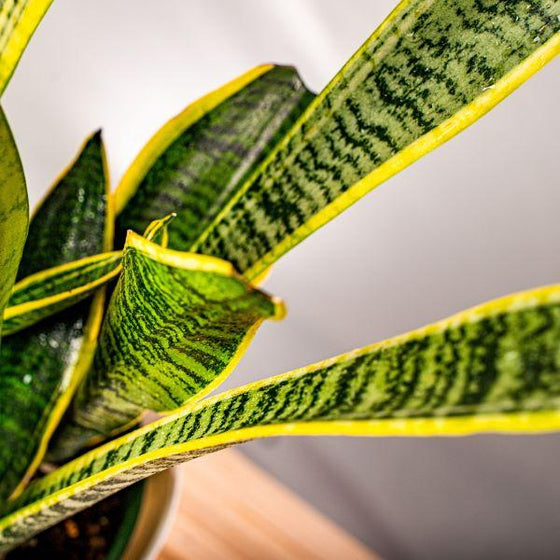Snake Plant Leaves Turning Yellow Can Be Fun For Everyone
Wiki Article
The 30-Second Trick For Snake Plant Leaves Turning Yellow
Table of ContentsSnake Plant Leaves Turning Yellow Things To Know Before You BuyExamine This Report on Snake Plant Leaves Turning YellowThe Buzz on Snake Plant Leaves Turning YellowSnake Plant Leaves Turning Yellow Fundamentals ExplainedThings about Snake Plant Leaves Turning YellowLittle Known Facts About Snake Plant Leaves Turning Yellow.
Here are seven reasons your snake plant's leaves can be transforming yellow and exactly how to fix it. A number of different plant troubles can cause yellow fallen leaves, or chlorosis. Chlorosis takes place when plants do not have the micronutrients they require to create chlorophyll, which makes vegetation eco-friendly and enables plants to transform sunshine right into food.Serpent plants are drought forgiving thanks to their delicious fallen leaves (Snake Plant Leaves Turning Yellow). These plants grow best in loosened, well-drained dirt that's allowed to dry totally in between waterings and might only need water when monthly throughout winter months. Overwatering can protect against origins from absorbing moisture and nutrients that the plant requires and can also create origin rot
A potbound plant can not soak up nutrients from the dirt. If your snake plant is chock-full or outgrowing its pot, this might be the reason of yellow leaves.
Rumored Buzz on Snake Plant Leaves Turning Yellow

If the fallen leaves on your snake plant are getting soft, it's normally an indication of way too much water. Snake plants store water in their fallen leaves and if they're overwatered, the fallen leaves can come to be soft and mushy. If you believe your snake plant is being overwatered, permit the dirt to dry out entirely before sprinkling once again.
Yes, some yellowing is regular and to be expected on older leaves, specifically as serpent plants age. If the plant is otherwise healthy and balanced and the leaves are just gently yellowed then there is no cause for issue. Nonetheless, if the fallen leaves are dramatically yellowed or if there are other indicators of distress after that it's best to do something about it.
Snake Plant Leaves Turning Yellow Fundamentals Explained

This can vary depending upon the dimension of the pot, the sort of potting mix, and the temperature level and humidity degrees. Generally, snake plants need to be sprinkled each to 2 weeks. Throughout the winter season, you can reduce watering to as soon as a month. If you assume your serpent plant has actually been overwatered, the primary step is to quit watering it.
With a little investigation, you need to be able to determine the reason and take actions to repair the issue and have a healthy and balanced snake plant. - Snake Plant Leaves Turning Yellow
Not known Factual Statements About Snake Plant Leaves Turning Yellow
The serpent plant is a trendy houseplant. The serpent plant is one of those plants official statement that are fantastic for growing inside your home in a terrarium, Snake plants can expand fairly big, however they also have a tendency to be rather low-maintenance.When the dirt is overwatered, the plant cells soak up even more water than they can keep. Check out here to Leaves come to be soggy and yellow as they absorb much more water. Sagging serpent plant fallen leaves Get More Info are triggered by soaked-up fallen leave cells losing their suppleness. You may notice that your snake plant will end up being black or brown if the yellow patches are not corrected by remedying overwatering.
It is, for that reason, more likely that your plant will certainly identify yellow spots on its fallen leaves if you overfeed it with plant food during winter season. The fallen leaves of serpent plants are also susceptible to yellowing when overfed, particularly if the origins are fragile. Repotting your yellowing, sprinkling only when the dirt dries out, and providing optimum temperature and light conditions can save it.
9 Simple Techniques For Snake Plant Leaves Turning Yellow
To stop yellowing triggered by overwatering, stop irrigating the snake plant up until the soil entirely dries out. Water your serpent plant only when the top 2 inches of dirt feel dry.Your can be gotten rid of by cutting off the yellow suggestions. The trimmed fallen leaves need have a peek at this site to expand longer if they are watered correctly and have optimum light and temperature level problems. It is essential to remember that the sharp ideas will not regrow, creating them to stand out from the remainder of the fallen leaves.
It won't take long for the leaves to regrow and grow like the healthy leaves around them. At the same time, you can eliminate affected fallen leaves from the base of the plant. The suggests that it's obtaining excessive or insufficient light or nutrients. The vital message is to permit the snake plant time to recoup.
The Ultimate Guide To Snake Plant Leaves Turning Yellow
So scroll the post till completion to find the option. Listen to this write-up right here: The circumstance can be anticipated if you have had your snake plant for a very long time, and yellowing takes place on the lower leaves as a natural aging cycle. Additionally, it is common for the Sansevieria leaves to transform yellow as a result of beginner blunders and when the plant is just purchased from the baby room for repotting.Some of one of the most usual reasons are listed here. Sansevierias like completely dry climates and choose little water kept at a void of one or two times weekly in summer and month-to-month in wintertime. When the water dosage obtains out of control, your Sansevieria will suffer from overwatering. One of the most common issue released by overwatering is root rot resulting in mushy roots and stems with a nasty odor.
Report this wiki page